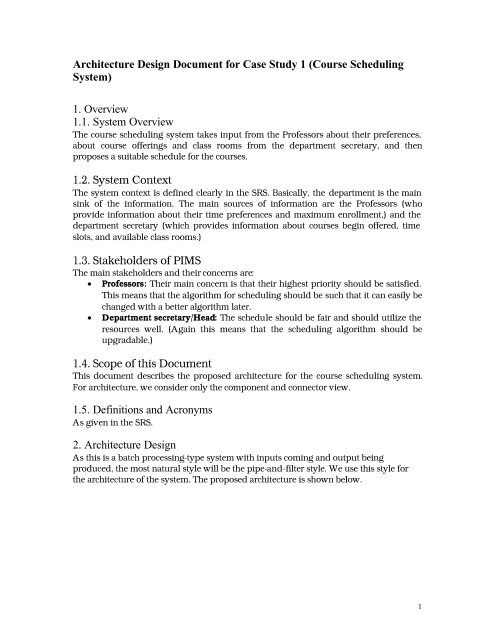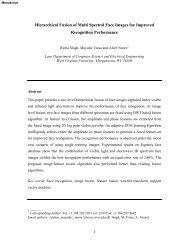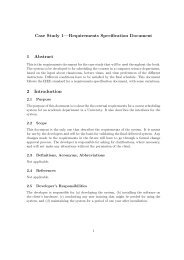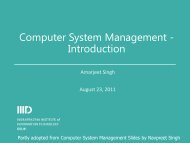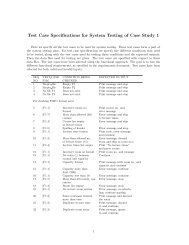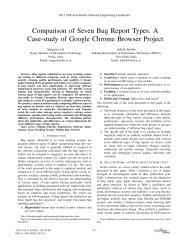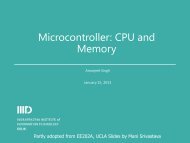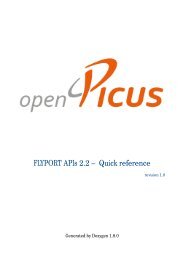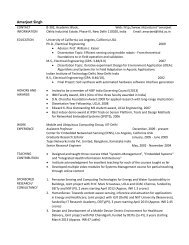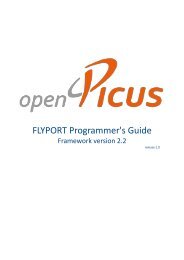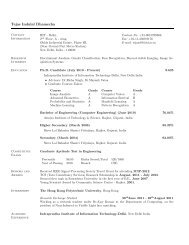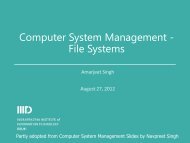Architecture Design Document for Case Study 1 (Course ... - IIIT
Architecture Design Document for Case Study 1 (Course ... - IIIT
Architecture Design Document for Case Study 1 (Course ... - IIIT
You also want an ePaper? Increase the reach of your titles
YUMPU automatically turns print PDFs into web optimized ePapers that Google loves.
<strong>Architecture</strong> <strong>Design</strong> <strong>Document</strong> <strong>for</strong> <strong>Case</strong> <strong>Study</strong> 1 (<strong>Course</strong> Scheduling<br />
System)<br />
1. Overview<br />
1.1. System Overview<br />
The course scheduling system takes input from the Professors about their preferences,<br />
about course offerings and class rooms from the department secretary, and then<br />
proposes a suitable schedule <strong>for</strong> the courses.<br />
1.2. System Context<br />
The system context is defined clearly in the SRS. Basically, the department is the main<br />
sink of the in<strong>for</strong>mation. The main sources of in<strong>for</strong>mation are the Professors (who<br />
provide in<strong>for</strong>mation about their time preferences and maximum enrollment,) and the<br />
department secretary (which provides in<strong>for</strong>mation about courses begin offered, time<br />
slots, and available class rooms.)<br />
1.3. Stakeholders of PIMS<br />
The main stakeholders and their concerns are:<br />
• Professors: Their main concern is that their highest priority should be satisfied.<br />
This means that the algorithm <strong>for</strong> scheduling should be such that it can easily be<br />
changed with a better algorithm later.<br />
• Department secretary/Head: The schedule should be fair and should utilize the<br />
resources well. (Again this means that the scheduling algorithm should be<br />
upgradable.)<br />
1.4. Scope of this <strong>Document</strong><br />
This document describes the proposed architecture <strong>for</strong> the course scheduling system.<br />
For architecture, we consider only the component and connector view.<br />
1.5. Definitions and Acronyms<br />
As given in the SRS.<br />
2. <strong>Architecture</strong> <strong>Design</strong><br />
As this is a batch processing-type system with inputs coming and output being<br />
produced, the most natural style will be the pipe-and-filter style. We use this style <strong>for</strong><br />
the architecture of the system. The proposed architecture is shown below.<br />
1
Errors in File1 Errors in file2 <strong>Course</strong> schedule<br />
Process File 1 Process File 2 Schedule the<br />
<strong>Course</strong>s<br />
File1<br />
File2<br />
This architecture has three filter components – one to process the in<strong>for</strong>mation provided<br />
in File 1, the other to process the in<strong>for</strong>mation provided in File 2, and the third to produce<br />
the schedule. As the in<strong>for</strong>mation produced by the first component is also used in the<br />
processing of in<strong>for</strong>mation from File 2 as well as <strong>for</strong> scheduling, the connections are set<br />
accordingly.<br />
In this architecture, we do not require that the components be executed in parallel. For<br />
ease of implementation, they may be executed in a sequential order, particularly since<br />
the file processing modules are not likely to consume much time – the main processing<br />
time will be needed by the third component and that remains the same in parallel or<br />
serial execution. Any (synchronous or asynchronous) method can be used to support the<br />
pipes.<br />
3. Evaluating the <strong>Architecture</strong><br />
Let us evaluate this architecture with respect to some properties.<br />
Criteria<br />
Change in some file<br />
<strong>for</strong>mat<br />
Change in<br />
scheduling<br />
algorithm<br />
Adding new<br />
constraints <strong>for</strong><br />
scheduling<br />
Replacing files with<br />
GUI<br />
Evaluation of the proposed <strong>Architecture</strong><br />
Good – change should impact only the filter<br />
<strong>for</strong> that file.<br />
Good – only the scheduling component needs<br />
to be changed.<br />
Good – only the scheduling component needs<br />
to be changed<br />
Poor – switching to a GUI interface will<br />
require changing almost the complete<br />
implementation with this architecture. The<br />
scheduling component can still be used.<br />
2
Extension to web<br />
based<br />
Provision of<br />
additional securities<br />
(passwords, etc)<br />
Poor – This architecture does not support this<br />
change; will require a complete rewrite of the<br />
system.<br />
Average – The architecture is not designed<br />
with security in mind. However, it is possible<br />
to add a security component <strong>for</strong> verification<br />
in the start.<br />
So the architecture satisfies the current main criteria of being able to change the<br />
scheduling algorithm. However, if the system is to be later enhanced to newer<br />
technologies or approaches, then most likely the system built using this architecture will<br />
not be reusable, and might have to be built afresh.<br />
3


